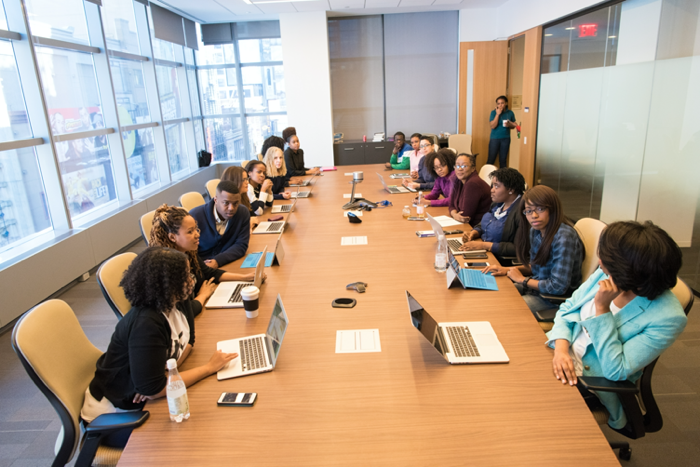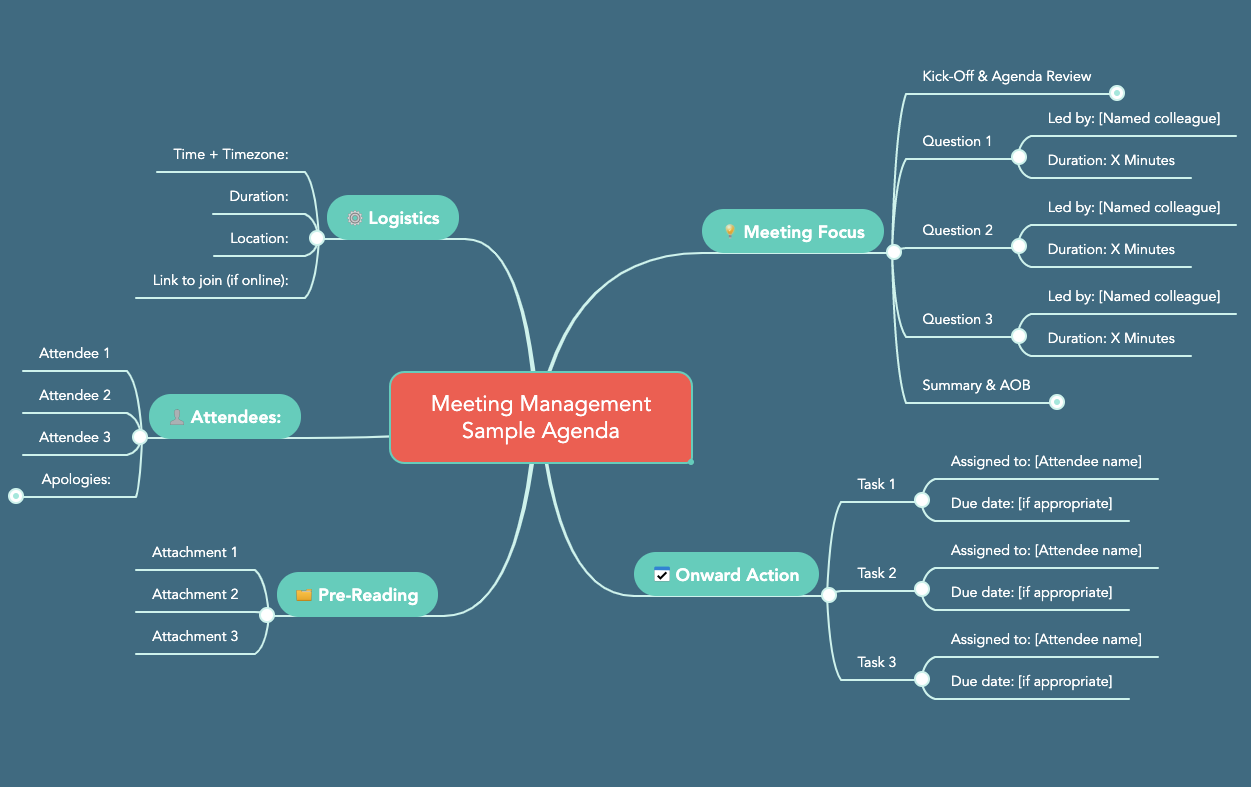A recent study of 19 million meetings found that workers in the U.S. spend an average of two hours a week in pointless meetings. And while that doesn’t sound like a lot, the exponential cost of two hours per person per week is massive. Altogether, these pointless meetings cost U.S. companies nearly $400 billion each year.

Companies can save a tremendous amount of money and improve their productivity greatly by simply having fewer pointless meetings. And the best way to limit the number of pointless meetings being held is to establish a set of meeting rules that everyone must follow.
10 Meeting Rules for Productive and Effective Meetings
If you feel that your company’s or team’s productivity is being drained by pointless, ineffective meetings, consider establishing these 10 meeting rules.
1. Hold meetings only when they’re absolutely required
Scheduling a meeting shouldn’t be an automatic response to every question or issue. Instead, people should be expected to seriously consider if a meeting is the appropriate format.
In an article for Harvard Business Review, time management coach Elizabeth Grace Saunders recommends asking these questions to determine if a meeting is what you truly need:
- “Have I thought through this situation?” Instead of scheduling a meeting at the first sign of a problem or the first time you’re asked a question you’re not sure how to answer, take time to think strategically and form a logical process for addressing the issue.
- “Does moving forward require a real-time conversation?” Workers waste far more time in meetings than they do answering emails. Before scheduling a meeting, determine if you can solve the problem simply by sending an email.
Status meetings—meetings where you meet to discuss or review progress—tend to be a particular drain on productivity. These meetings can be easily done away with altogether by adopting task management software that lets everyone see progress on a project in real-time.
2. Only invite people who are truly needed

Instead of inviting everyone to your meeting, only invite those people whose input is absolutely required.
A lot of times, people will send meeting invites to an entire distribution list, allow guests to forward the meeting invite to others, or simply add everyone who’s in any way involved in a project.
The result: massive meetings that are difficult to keep on track, and lists of attendees who have nothing to contribute to or gain from the meeting.
According to Michael Mankins, co-author of Time, Talent, Energy, people often feel that they don’t have the authority to turn down meeting invitations—particularly from higher managers—even if they feel like the meeting will be unproductive.
Therefore, the responsibility sits with the meeting organizer to determine exactly who will bring real value and decision-making power to a meeting before sending out invitations.
Amazon’s CEO Jeff Bezos, who famously meets with his investors for just six hours per year, has a two-pizza rule: no meeting should be held with more people than can be fed with two pizzas.
By restricting meeting sizes, Bezos claims that meetings move faster and conversations are purely between people with decision-making power.
If you’re on the receiving end of too many invitations to pointless meetings, consider adopting these five strategies for attending fewer meetings.
3. Assign a meeting facilitator
To run effective meetings, someone needs to be facilitating. The facilitator’s role is to ensure that the meeting starts and ends on time, covers and sticks to the agenda, and follows all established meeting rules.
The key responsibility of the meeting facilitator is to create an environment where attendees can work together to reach an effective solution or conclusion within the designated time. That might include things like:
- introducing attendees
- ensuring everyone is given time to share his/her input, and
- cutting off off-topic discussions
The logical facilitator for any meeting is the person who’s organizing the meeting, so if you’re sending meeting invites to your coworkers, you should be prepared to act as its facilitator and keep the meeting you scheduled on track so it’s productive for all attendees.
4. Set up meeting equipment in advance
If you’re hosting your meeting in a conference room, head over to that conference room before your meeting begins to get set up and make sure you have everything you need.
Why is this important? It’s not a good use of anyone’s time to sit around for 15 minutes watching the meeting organizer struggle to get the projector working.
If another meeting is scheduled just before yours that will prevent you from setting up early, check the meeting room at the end of a workday when it’s empty and make sure it has everything you need. You don’t want to find out that you needed an adapter for the projector seconds before your meeting begins.
Finally, it’s also a good idea to double-check your meeting invite to make sure any remote participants have the details they need to join your meeting, such as dial-in numbers and meeting codes. Check to make sure those details are included in your invitation—and that they’re accurate.
5. Share a meeting agenda in advance
Sharing an agenda for your meeting well before the meeting takes place helps attendees see what’s going to be expected of them during the meeting. This helps them gather any information they may need in order to participate in the meeting productively.
If the people you’ve invited don’t know what they need to prepare for, you run the risk of having to host a follow-up meeting to discuss details you couldn’t gather in the first meeting because people didn’t know what questions they were going to be asked or what information they would need to provide.
6. Take and share meeting notes
The best team meetings result in a clear, shared understanding of what’s needed next, including actionable, assigned tasks.
It’s the role of the meeting facilitator or assigned notetaker to ensure that all takeaways, actionable items, and decisions are documented and shared with attendees after the meeting.
When taking notes in meetings, notetakers should focus on:
- Facts (e.g. “Jenna is the creative lead on this project.”)
- Issues (e.g. “There is too much work to complete by the deadline.”)
- Decisions (e.g. “We will break this project up into smaller, more manageable chunks.”)
- Action Plans (e.g. “The project manager and creative lead will determine how to break this project up.”)
- Questions and Answers (e.g. questions that couldn’t be answered during the meeting or answers provided to questions that were asked during the meeting)
Taking detailed meeting notes is also important if you’re following the second meeting rule on this list: only invite people who are truly needed.
If you’re limiting your invite list, meeting notes are useful for people who need to know the outcome of the meeting even though they didn’t need to be involved in the meeting itself.
7. Give everyone the opportunity to participate

In a typical eight-person team meeting, three people do 70% of the talking.
As the meeting facilitator, there are a number of things you can do to encourage a better balance and give everyone a chance to participate.
First, you can help people come to the meeting more confident and ready to participate. This can be achieved by sharing key questions you’re planning to ask and problems you’re hoping to solve before the meeting (via a meeting agenda) so people can come to the meeting prepared.
Second, during the meeting, it’s the role of the facilitator to ensure that the meeting isn’t dominated by one or two attendees. This can be done by actively asking less assertive attendees their opinions during the meeting or watching for physical cues that someone is struggling to break into the discussion.
Not everyone is comfortable fighting for the floor, but most will happily speak up if you offer them the opportunity. And if you’ve shared the meeting agenda in advance and asked attendees to prepare, there’s also less of a risk that you’re putting them on the spot.
Find more tips like these in our guide to inclusive team meetings.
8. Limit discussion times for each agenda item
Meetings should be no longer than an hour, as sixty minutes is generally the longest time people can remain truly engaged. To this end, it’s important that your meeting finishes on time.
To make sure you don’t run out of time before covering every item on your agenda, it helps to limit the amount of time you’ll spend on each topic you need to cover. Consider allocating a specific amount of time to each agenda item. Then, when time’s up, move on.
If you don’t want to bound discussions by set time limits, you should at least make sure to list the most important items higher up on the agenda so they’re covered first.
9. Ban unnecessary devices

To make your meetings faster and more effective, ensure team members respect other meeting attendees by actively listening. It’s a fact that it’s much harder to listen when you’re multitasking—checking emails, replying to IMs, or making lunch plans via text messages.
If you’re meeting in-person, ask attendees to stay off their phones and laptops unless they need them to take meeting notes. When hosting an online meeting, this can be more difficult to control. However, asking all attendees to keep their cameras on can help.
The good news: if you’re only inviting people who are truly needed, keeping your meetings limited to a reasonable amount of time, and sticking to your agenda, attendees will be less likely to multitask because your meetings will be more valuable for them to pay attention to.
10. Speak slowly and clearly when presenting
When speaking publicly, Carmine Gallo, author of Talk Like TED, advises speaking at a rate of 190 words per minute. If you speak much faster, you can end up sounding nervous—as if you’re trying to get it over with as soon as possible.
When holding a meeting online, this is even more important. According to Susan Colaric, Assistant Vice President for Instructional Technology at Saint Leo University:
Video-conference meetings should actually move at a slightly slower pace than a typical meeting due to a two- to three-second delay for most systems to communicate.
“If you’re leading the meeting,” Colaric says, “make sure there are sufficient pauses after asking a question. If you are a participant, bring attention to yourself before addressing the group by signaling with your hand or saying ‘question’ or ‘comment,’ and then waiting a couple of seconds before continuing.”
Adopt An Effective Post-Meeting Workflow
One final important part of conducting effective meetings is what you do after the meeting is over.
After a meeting, it’s important to recap the decisions made in the meeting, share your recap with attendees via email, and assign any tasks to relevant people.
Having a written meeting recap gives people something to point to if there are questions down the line about how and why certain decisions were made. Additionally, if you assign people the tasks they’re responsible for, you can make sure those tasks are completed (so a follow-up meeting isn’t required).
If you follow these meeting rules for every meeting you schedule, you’ll be doing your part to limit the number of pointless meetings and reduce the waste of unproductive meetings.
Best of all, if you gain a reputation for being someone who runs truly productive meetings, your coworkers will appreciate that you value their time and will make more of an effort to attend your meetings in the future.



